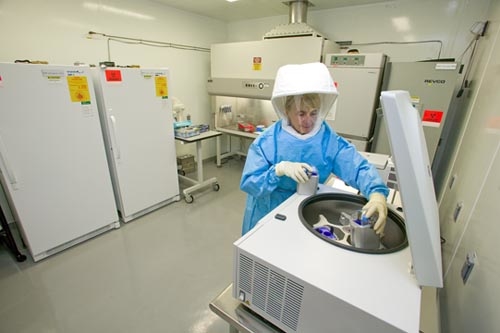Certifying continued operation of BSL-3 facility
 (Download Image)
Lab biomedical researcher Kris Montgomery works inside the BSL-3 facility at LLNL.
(Download Image)
Lab biomedical researcher Kris Montgomery works inside the BSL-3 facility at LLNL.
A pair of fresh approvals have been received for the operation of the Laboratory's newest biological research facility — the Biological Safety Level 3, or BSL-3 facility.
The approvals, received last week from the Atlanta-based Centers for Disease Control and Prevention (CDC), are for the facility's select agent registration and its annual recertification.
"This facility is critical for the Lab to continue to play an important role for the nation in biodefense and to assist in preventing infectious diseases," said BSL-3 Manager Eric Gard, who oversees LLNL's work with select agents.
On March 11, the CDC approved the Laboratory's select agent registration, which is a three-year permit and certifies that the Lab has met all of the CDC's requirements for handling select agents. (Select agents are pathogens that can only be studied in enhanced safety and security facilities).
As a part of the CDC process for renewing the Lab's select agent registration, CDC officials checked the facility's emergency response plans, inventory controls, biosafety controls, security systems, record-keeping and training.
Also on March 11, the Laboratory received word from the CDC that the BSL-3 facility had been recertified for operation for the next year, Gard said.
In the recertification effort, CDC officials checked that the facility's policies and procedures for operations and maintenance are up to date and that safety checks had been conducted on all of the building's systems.
The safety checks included testing the biosafety cabinets to ensure that they have proper airflow and verifying that the building's High Efficiency Particulate Air (HEPA) filters are functioning properly, Gard said.
In addition, the building's systems were tested to make certain that they would function properly if any components failed, such as might happen during an earthquake if the building needed to switch to emergency backup power.
"We received excellent support from the Laboratory's Maintenance & Utilities Services Department, Facility Management Department and Hazards Control during our recertification process. They provided assistance in performing all the failure mode testing and evaluation," Gard added.
The Laboratory's BSL-3 facility, which came on line in January 2008, is the only such facility among Department of Energy national laboratories.
New research efforts at the Lab facility are to study how Francisella tularensis (or rabbit fever) circumvents the human immune system to cause disease and how this pathogen persists in the environment.
Lab immunologist Amy Rasley leads the research team that is seeking to understand the differences in the virulence of various strains of F. tularensis for humans and how the organism affects people differently.
"This research might ultimately help in the development of a therapeutic for human tularemia as well as improve detection efforts," Rasley said.
Undertaken in collaboration with researchers from Brigham Young University and Stanford University, the F. tularensis research is being funded by the National Institutes of Health and through the Laboratory Directed Research and Development Program.
Besides Rasley, other LLNL members of the research team are two postdoctoral fellows and microbiologists, Sahar El-Etr and Duncan Parsons, biostatistician Kevin Mcloughlin, and biomedical scientists Victoria Lao and Shelley Corzett.




